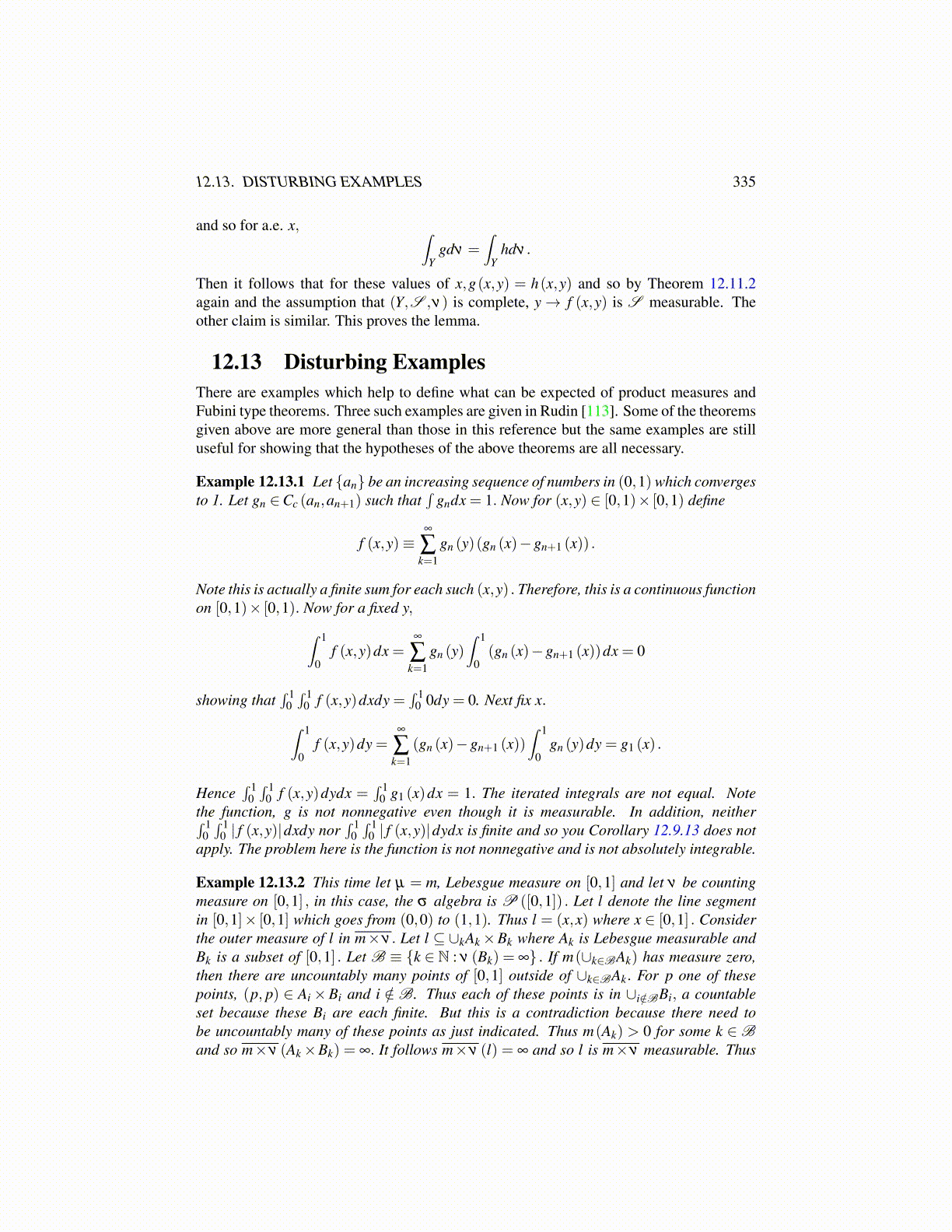
12.13. DISTURBING EXAMPLES 335
and so for a.e. x, ∫Y
gdν =∫
Yhdν .
Then it follows that for these values of x,g(x,y) = h(x,y) and so by Theorem 12.11.2again and the assumption that (Y,S ,ν) is complete, y→ f (x,y) is S measurable. Theother claim is similar. This proves the lemma.
12.13 Disturbing ExamplesThere are examples which help to define what can be expected of product measures andFubini type theorems. Three such examples are given in Rudin [113]. Some of the theoremsgiven above are more general than those in this reference but the same examples are stilluseful for showing that the hypotheses of the above theorems are all necessary.
Example 12.13.1 Let {an} be an increasing sequence of numbers in (0,1) which convergesto 1. Let gn ∈Cc (an,an+1) such that
∫gndx = 1. Now for (x,y) ∈ [0,1)× [0,1) define
f (x,y)≡∞
∑k=1
gn (y)(gn (x)−gn+1 (x)) .
Note this is actually a finite sum for each such (x,y) . Therefore, this is a continuous functionon [0,1)× [0,1). Now for a fixed y,∫ 1
0f (x,y)dx =
∞
∑k=1
gn (y)∫ 1
0(gn (x)−gn+1 (x))dx = 0
showing that∫ 1
0∫ 1
0 f (x,y)dxdy =∫ 1
0 0dy = 0. Next fix x.∫ 1
0f (x,y)dy =
∞
∑k=1
(gn (x)−gn+1 (x))∫ 1
0gn (y)dy = g1 (x) .
Hence∫ 1
0∫ 1
0 f (x,y)dydx =∫ 1
0 g1 (x)dx = 1. The iterated integrals are not equal. Notethe function, g is not nonnegative even though it is measurable. In addition, neither∫ 1
0∫ 1
0 | f (x,y)|dxdy nor∫ 1
0∫ 1
0 | f (x,y)|dydx is finite and so you Corollary 12.9.13 does notapply. The problem here is the function is not nonnegative and is not absolutely integrable.
Example 12.13.2 This time let µ = m, Lebesgue measure on [0,1] and let ν be countingmeasure on [0,1] , in this case, the σ algebra is P ([0,1]) . Let l denote the line segmentin [0,1]× [0,1] which goes from (0,0) to (1,1). Thus l = (x,x) where x ∈ [0,1] . Considerthe outer measure of l in m×ν . Let l ⊆ ∪kAk×Bk where Ak is Lebesgue measurable andBk is a subset of [0,1] . Let B ≡ {k ∈ N : ν (Bk) = ∞} . If m(∪k∈BAk) has measure zero,then there are uncountably many points of [0,1] outside of ∪k∈BAk. For p one of thesepoints, (p, p) ∈ Ai×Bi and i /∈B. Thus each of these points is in ∪i/∈BBi, a countableset because these Bi are each finite. But this is a contradiction because there need tobe uncountably many of these points as just indicated. Thus m(Ak) > 0 for some k ∈Band so m×ν (Ak×Bk) = ∞. It follows m×ν (l) = ∞ and so l is m×ν measurable. Thus